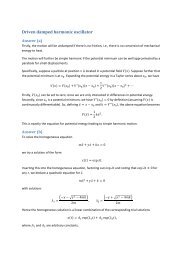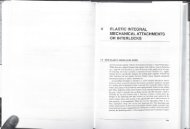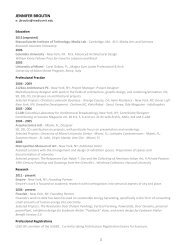Snap-Fit Joints for Plastics - A Design Guide - MIT
Snap-Fit Joints for Plastics - A Design Guide - MIT
Snap-Fit Joints for Plastics - A Design Guide - MIT
Create successful ePaper yourself
Turn your PDF publications into a flip-book with our unique Google optimized e-Paper software.
Cantilever <strong>Snap</strong> <strong>Joints</strong> B<br />
Calculation example II<br />
snap-fitting hook<br />
This calculation example is <strong>for</strong> a snap-fitting<br />
hook with a segmented ring cross section<br />
decreasing in thickness from h at the root to h/2<br />
at the end of the hook (see Fig. 20). This<br />
is design type 2, shape C in Table 1.<br />
This taper ratio should be used when possible to<br />
evenly distribute stresses during arm deflection.<br />
It also reduces material usage.<br />
Given:<br />
a. Material = Bayblend® PC/ABS<br />
b. Length (1) = 25.4 mm (1.0 in)<br />
c. Angle of arc (�) = 75°<br />
d. Outer radius (r 2) = 20 mm<br />
(0.787 in)<br />
e. Inner radius (r 1 ) = 17.5 mm<br />
(0.689 in)<br />
f. Thickness (h) = 2.5 mm (0.1 in)<br />
g. �/ =�/2=37.5°<br />
Find:<br />
a. The maximum allowable deflection <strong>for</strong> a<br />
snap-fit design which will be assembled<br />
and unassembled frequently.<br />
Fig. 20: <strong>Snap</strong>-fitting hook, design type 2, shape C<br />
Solution:<br />
The permissible strain <strong>for</strong> a one-time snap-fit assembly in Bayblend® resin is 2.5%. Since the<br />
design is <strong>for</strong> frequent separation and rejoining, 60% of this value should be used or � pm = (0.6)<br />
(2.5%) = 1.5%.<br />
Deflection equation from Table 1, type 2, shape C: y = 1.64 K (2) � 1<br />
The variable <strong>for</strong> K (2) can be obtained from the curves in Fig. 10. Note that if the member is<br />
deflected so that the tensile stress occurs in the convex surface, the curve <strong>for</strong> K1 should be used;<br />
if it occurs in the concave surface, K2 should be used. In this case, the tensile stress will occur in<br />
the convex surface, there<strong>for</strong>e the curve <strong>for</strong> K2 should be used.<br />
2<br />
r2 r 1/r 2 = 0.875 and 0 = 75°<br />
from Fig. 10, K (2) = K2 = 2.67<br />
(2.67) (0.015) (25.4 mm) 2<br />
y – 1.64 = 2.11 mm (0.083 in)<br />
20 mm<br />
Alternate Solution:<br />
This method may be used as a check or in place of using the curves in Fig. 10.<br />
Deflection equation from Table 1, type 2, shape D: y = 0.55<br />
The value <strong>for</strong> c (3) which is the distance from the neutral axis to the outermost fiber, can be<br />
calculated from the equations shown below:<br />
c2 = r2[1– 2 sin � (1 – h/r2 + 1 )]<br />
3 �<br />
2–h/r2 c1 = r2[ 2 sin � + (1 – —) h 2 sin � –3� cos � ]<br />
Use c 2 <strong>for</strong> c (3) , if the tensile stress occurs in the convex side of the beam. Use c 1 <strong>for</strong> c (3) if the<br />
tensile stress occurs in the concave side. For this particular problem, it is necessary to calculate c 2 .<br />
c (3) = c2 = 20 mm [1<br />
2 sin 37.5<br />
(1 – +<br />
2.5 mm 1<br />
] = 2.52 mm<br />
3 (0.654)<br />
Solving <strong>for</strong> y using c2 yields;<br />
20 mm 2 – 2.5 mm/20mm<br />
y = 0.55 (0.015) (25.4 mm)<br />
Both methods result in a similar value <strong>for</strong> allowable deflection.<br />
= 2.11 mm (0.083 in)<br />
2<br />
(2.52 mm<br />
� 1 2<br />
3�(2 _ h/r 2) r 2 3�<br />
Page 17 of 26 <strong>Snap</strong>-<strong>Fit</strong> <strong>Joints</strong> <strong>for</strong> <strong>Plastics</strong> - A <strong>Design</strong> <strong>Guide</strong><br />
18





